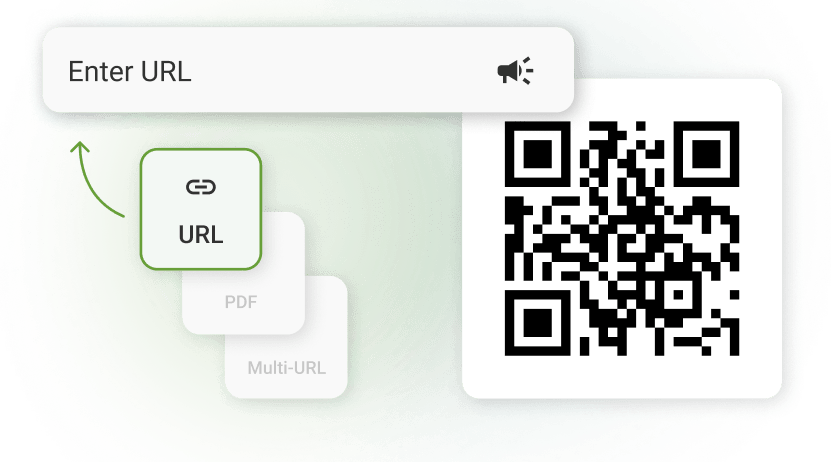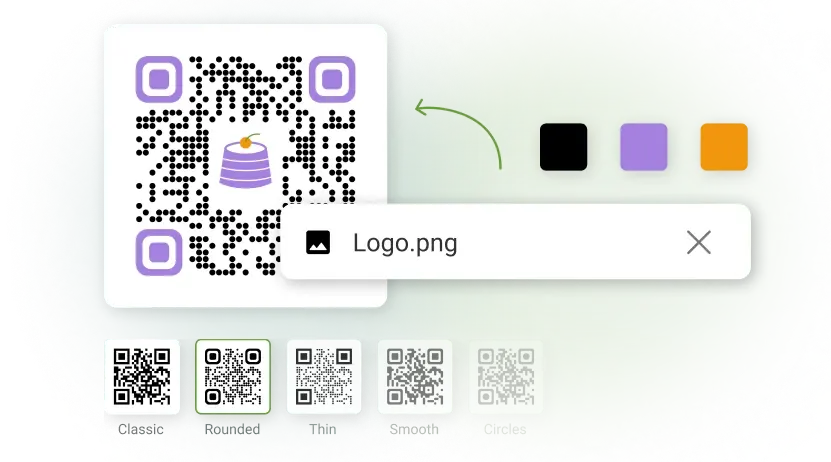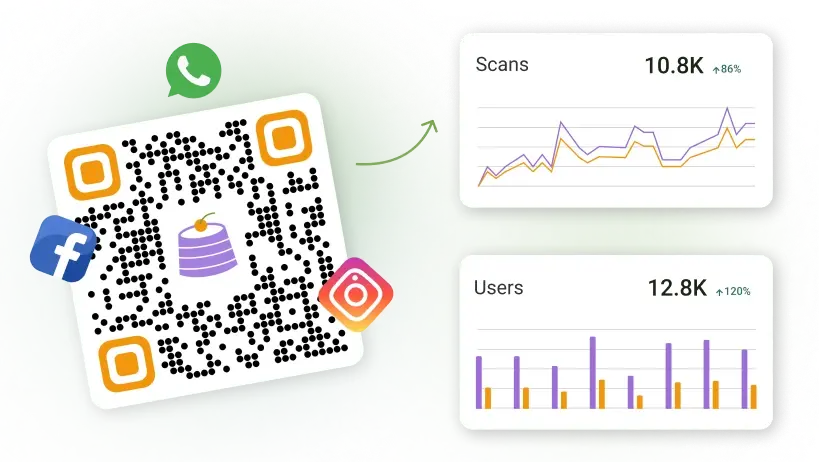A customer walks into your bookstore, sees a QR Code on a display, scans it with their phone, and watches the author talk about their new book. There are no app downloads or complicated steps—just point, scan, and connect.
QR Codes bring this kind of smooth connection to small businesses today. Whether you run a coffee shop, plan events, or own a store, QR Codes can connect your physical space to your customers’ digital world.
We’ve helped thousands of small businesses discover how these versatile tools work in practice. The results speak for themselves—reduced costs, better customer engagement, and optimized operations.
Table of Contents
- What makes QR Codes perfect for small businesses
- Best practices on getting started with QR Codes
- Make QR Codes work for your business
What makes QR Codes perfect for small businesses
QR Codes offer small businesses an advanced, affordable bridge between the physical and digital worlds. Simply add one to your packaging, flyer, or storefront. With a quick scan, customers can instantly view your menu, pay online, follow your social media, or visit your website.
They’re easy to set up, work with any smartphone camera, and require zero special apps or technical know-how.
QR Codes are now familiar. Since 2020, scanning them has become second nature for most people, eliminating friction and driving immediate action. This widespread comfort opens the door to several key benefits for small businesses.
1. Save money on printing and materials
All small businesses monitor costs closely. Traditional marketing materials like flyers, brochures, and posters can cost a lot over time. You have to print new ones whenever you need to update information or run seasonal promotions.
💡Did you know? Printing costs are a big part of business expenses, sometimes reaching up to $725 per employee each year.
QR Codes cut reprint costs and waste. Print one dynamic QR Code on your most-used customer touchpoints (like menus, flyers, or signage). Then simply update the online content it points to—no more constant, expensive reprinting. The savings add up quickly over time.
💁Picture this: A local bakery used to print new menu cards weekly to showcase their specials. Now they print QR Codes once and update their digital menu whenever needed. This simple switch saves them hundreds of dollars monthly. This also keeps customers better informed about daily offers. A small bookstore replaced printed event flyers with QR Codes on shelf talkers. When they host events, they can now update the linked webpage instead of reprinting materials.
2. Make customers more engaged
QR Codes allow your customers to find your website or social media with a scan. No more typing it out manually. This convenience creates real engagement.
When customers can immediately watch a demo, read reviews, or find exclusive content, they’re more likely to take action and connect with your business.
💁Picture this: A family restaurant puts QR Codes on tables that link to a page with the chef’s daily specials, photos, and stories behind each dish. Customers appreciate the personal touch, and the restaurant could see 20% more orders for featured items.
You can use QR Codes to link to:
- Product demos or how-to videos
- Customer reviews or testimonials
- Behind-the-scenes content
- Your social media pages
- Special deals or current offers
| Tip: The key is making the destination worthwhile—don’t just link to your homepage. Create specific, valuable content that rewards the scan. |
3. Track what’s working in your business
Understanding which marketing efforts bring in customers is challenging for every small business. QR Codes solve this puzzle by providing precise data about customer behavior.
Trackable QR Codes let you see when, where, and how often people scan them. You can see what’s working and where to focus your budget and marketing efforts.
💁Picture this: A local fitness studio used different QR Codes on their marketing materials—one on window displays, one on social media, and one on business cards. After a month, they saw that the QR Code on the window brought in the most new members. So, they decided to focus more on making their storefront stand out.
With QR Codes, you can track:
- How many scans happen each day, week, or month
- Which locations get the most scans
- What times of day do people scan the most
- What types of devices do people use
- Where your audience is located
This information becomes your roadmap for improving marketing results and understanding customer preferences.
4. Fit QR Codes into any marketing plan
QR Codes work everywhere, from tiny business cards to large storefront signs. This versatility means you can use them on promotional items, such as:
- Business cards for instant contact
- Product tags for reviews or how-to videos
- Event flyers for schedules and speaker information
- Packaging for warranty sign-up or customer support
- Ads for tracking direct responses
💁Picture this: A local salon adds the same QR Code design to its business cards, storefront window decals, and service flyers. Scanning the QR Code takes clients to the salon’s online booking page, current specials menu, and new stylist portfolios.
This consistent presence does two things:
- Clients learn to expect value; they know scanning will get them something useful, fast.
- It reinforces the brand. The QR Code becomes a trusted shortcut, turning every touchpoint into a direct line to services and offers.
Consistency matters here. Customers who see your QR Codes across many touchpoints learn to expect valuable content behind each scan.
5. Make daily operations smoother
QR Codes extend beyond marketing to operational efficiency. Many small businesses use them to reduce manual tasks and create contactless experiences.
💁Picture this: A clinic can use QR Codes for patient check-ins. This allows people to update their information before appointments. They can also answer screening questions through the QR Code. This reduces waiting room time and paperwork for staff members.
For local retail stores, QR Codes can help with inventory tracking, helping employees update stock and find products quickly. These time savings add up during busy days, making work easier for staff. QR Codes can also be used to give staff quick access to training materials and procedures.
Start with one simple operational use case, master it, then expand to other business areas. The learning curve is gentle, but the efficiency gains can be substantial.
6. Share detailed information instantly
Traditional marketing materials have space limitations that can frustrate business owners. QR Codes eliminate this constraint by linking to an unlimited digital space. You can easily share comprehensive information about your products, services, or business story.
💁Picture this: A local museum uses QR Codes on exhibits to provide detailed historical context, audio guides, and interactive content. Without the space limits of small informational placards, visitors can now explore topics more deeply based on their interests.
This works well for any business that needs to explain its products or services. You can share:
- Product details and specs
- Step-by-step instructions
- Service menus with prices
- Staff bios and qualifications
- Company history and values
- Customer success stories
⚡Fun fact: QR Codes can store up to 7,000 characters, while traditional barcodes hold only about 20 characters. This capacity difference opens up new and creative ways to communicate with customers.
7. Go green and reduce waste
Today, customers make choices based on how eco-friendly a business is. QR Codes help small businesses lower their environmental impact. Instead of printing flyers, menus, or brochures, they can share digital versions.
💁Picture this: A local café eliminated monthly specials flyers and table tents by switching to QR Codes on counter cards and receipts. This simple shift can save about 15,000 sheets of paper annually and reduce print logistics emissions. Customers scanning the code see real-time seasonal menus, loyalty rewards, and barista profiles. Due to this, engagement increases as content stays fresh. The move can also reinforce their eco-brand, drawing praise from sustainability-focused patrons.
By using digital content and QR Codes:
- You use much less paper and ink, saving resources
- You need fewer deliveries, which lowers pollution and your carbon footprint
- It’s easy to update digital content, so you waste less time
- It shows your business cares about the environment
- You can use the money you save for other green efforts
- You can attract customers who prefer sustainable businesses
8. Add exciting experiences with AR
QR Codes can unlock augmented reality (AR) experiences that set you apart from competitors. These interactive experiences happen on customers’ mobile devices without special app downloads.
With a quick scan, customers can:
- Try on products or see how they fit in their space
- View 3D demos
- Play games or join contests
- Take virtual tours
- Get smart business cards with floating information
💁Picture this: A boutique furniture store adds QR Codes to its showroom displays. Customers scan a code next to a sofa, then point their phone camera at their living room. Instantly, they see the sofa in 3D, test different fabric colors, and even walk around it—all through their mobile phone screen.
The “try before you buy” AR experience has two major benefits:
- Reduced returns: Customers can see how items fit and look in their homes, leading to fewer surprises and returns.
- Increased confidence: Shoppers can feel confident in their purchase as they know what to expect before buying.
Many simple AR tools now integrate with QR Codes, making this technology accessible for small businesses.
⚡Fun fact: According to the Uniqode State of QR Code Report, 92% of businesses expect AR use to grow. They see QR Codes as a simple way to offer engaging, interactive experiences.
9. Build better customer loyalty programs
QR Codes make loyalty programs more convenient for customers and easier for businesses to manage. Instead of carrying punch cards or receipts, customers scan a QR Code to earn points, check balances, and redeem rewards. You can also celebrate special occasions with them and add referral programs
💁Picture this: A local bar puts QR Codes on cups and glasses that customers scan to earn points toward free drinks. The system automatically tracks every purchase. It then sends personalized offers based on preferences and visit frequency.
QR Codes help you create a customer experience that encourages repeat visits. The data collected helps small businesses understand customer patterns and preferences.
10. Target local customers with special offers
QR Codes can deliver location-specific promotions, encouraging nearby customers to visit your business. This geo-targeting capability helps drive foot traffic and creates urgency around special offers.
💁Picture this: A restaurant chain places QR Codes on local billboards that offer 15% discounts to customers who scan and visit within 24 hours. The location data from these trackable QR Codes helps track which neighborhoods respond best to your ads.
Local businesses can use this strategy to compete with larger chains. They can offer personalized, community-focused promotions that bigger competitors can’t match.
You can offer local discounts that are time-sensitive or tied to specific neighborhoods. You can run promotions around local events to attract nearby customers. You might also respond to competitor deals to keep up or stay ahead.
Adjusting offers based on the weather, such as ice cream on hot days or coffee during cold snaps—adds relevance. This targeted approach helps small businesses get more from their marketing budget by focusing on the people most likely to stop in.
Best practices on getting started with QR Codes
Starting with QR Codes doesn’t require a major investment or technical expertise. Begin small and build confidence before expanding to more complex campaigns.
Choose one simple goal—maybe linking to your Google reviews or contact information. Create your QR Code using a reliable generator with tracking and customization options. Test the code thoroughly by scanning it with different phones to ensure it works properly across various devices.
Place your QR Codes strategically where customers naturally look and have time to scan. Track the results by checking scan data weekly and adjusting placement or content based on what you learn.
Always include clear instructions like “Scan for special offers” or “Scan to see our menu.” Make codes large enough to scan—at least one inch square works best. Ensure the destination content is mobile-friendly because people will view it on phones. Update linked content regularly to keep it fresh and relevant. Test codes before printing or publishing to avoid embarrassing mistakes.
Lastly, start with temporary signs, such as table tents, to test what works before adding permanent ones. This approach lets you refine your strategy without significant upfront costs.
Make QR Codes work for your business
QR Codes solve real problems for small businesses. They cut printing costs, engage customers, and simplify daily operations.
Start simple. Use QR Codes when they improve your customers’ experience and make your business run smoother.
The QR Code Generator helps you create, customize, and track codes that deliver real results. It gives you these features without tech troubles or upkeep worries.
Get started for free in just 3 steps. See how simple tools can transform your customer interactions today!







